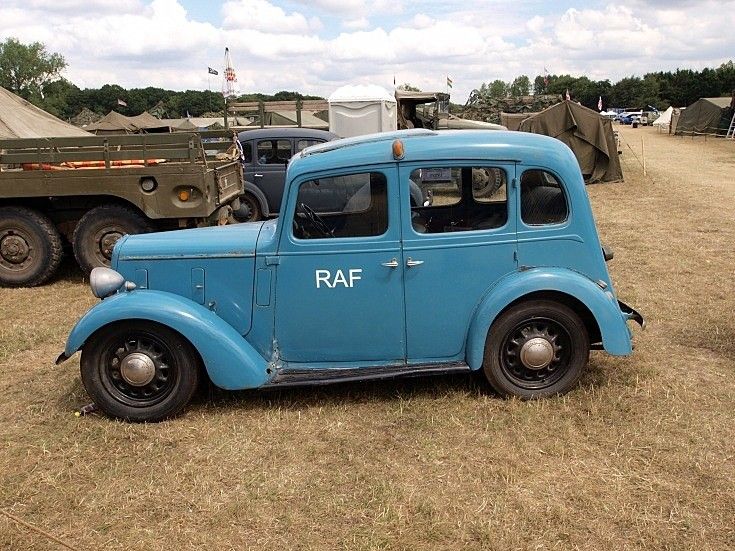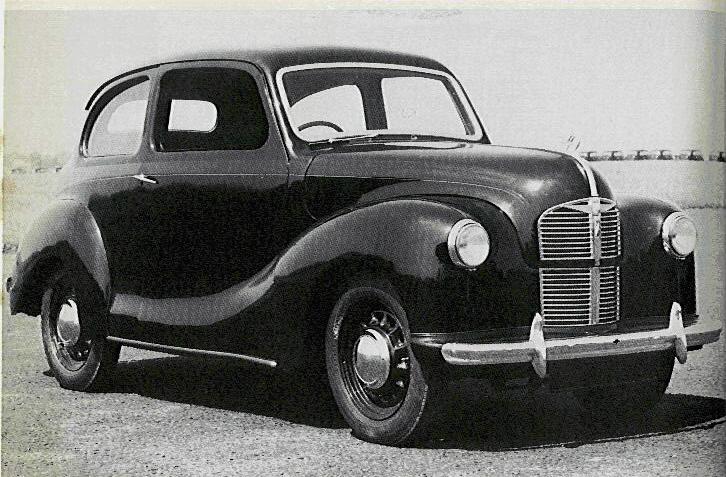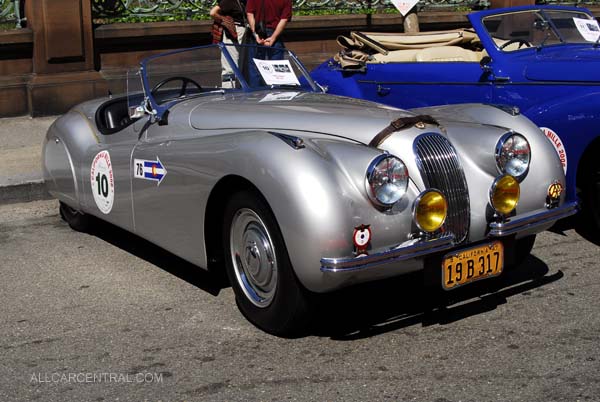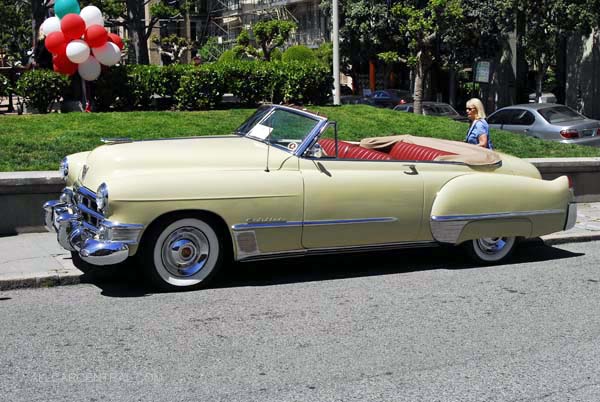A Brief History Of The Motor Car Chapter 4
A BRIEF HISTORY OF THE MOTOR CAR
Chapter 4 Post War America
CHAPTER FOUR.. Post War America
WWII ended in August 1945 and without exception most people were happy. Peace and prosperity from now on and the world could get back to a new and wonderful future...Well most of it could!
Austin RAF saloon 1942
Submitted by
Rick Feibusch, 2012

However across the Atlantic of Europe was in ruins. The German, Italian... French...Dutch etc., industries out of existence, tens of thousands of homes destroyed, transport a complete shambles, the only reliable means of transporting anything was by water and even the once famous European cannel systems were damaged in company with most railway services and highways. The once famous factories that produced such vehicles as Mercedes... Alfa Romeo... BMW... Citron... etc had also been seriously damaged to be replaced by piles of rubble and empty shells of what once was the pride of European production.
Very little
in the way of consumer goods had been produced for four years in America especially as far as vehicles were concerned, the same applied to various other countries around the world even those that were not directly involved with the conflict. Demand for almost everything was high especially vehicles. Within a few months the US industrial complex was back to producing consumer items from washing machines to motor cars, radios to refrigerators. World demand was at its peak and no matter what you produced it would be snapped up by a hungry consumer, good or not so good. Most of the cars produced and offered to the public in the two/three years after the war were little more than prewar vehicles with very little refinement in either performance or appearance but no one seemed to object.
Austin A40 Prototype 1946
Submitted by
Rick Feibusch, 2010

The only other country whose industry had not been totally damaged was Britain in fact two British car manufacturers had production cars on the market as early as September 1945 however as with the US they were simply prewar models assembled from parts stored during the war. As I have indicated whatever you made someone somewhere was in the market to purchase from Australia to South America, Canada to Japan and of course your own home market. In 1947 A would be American purchaser could wait as long as three/four months for his new car. In Britain it was over a year as whatever production was available was directed to overseas markets to try and clear Britain's war debt, the motto of the day was "Export or Die". In this situation American commerce was on a boom cycle factories were seeking workers while the production of material to feed this boom was also working at full capacity.
Jaguar XK120 1949

Looking at the cars offered from 1946 through to the early 1950's there was little to be excited about, most of the technical development created during the war had yet to filter down to the private motor car. The engines were much the same as the units that your father's vehicle enjoyed twenty years earlier. Chrome was certainly in vogue more so than in the thirties and the chrome front appearance seemed to be aggressive. A motor magazine in 1950 suggested that this was due to the emergence of the Cold War. With such design making a statement... (Interesting but I don't quite agree). Front bench seats were the fashion in company with a steering column gear change, metal front dash and large instruments set in more chrome. Styling started to change and in 1949 a British car hit the American headlines and sent the sports car world into a spin. The new Jaguar 120 first shown at the London Motor show created quite a sensation. One American Dealer wanted to buy the total years production but as the British Government had total control on all such production he was unlucky.
Not only did the government have export control they also had total control of steel production...The railways...Highway transport and of course fuel. (Gasoline was still sternly rationed in the post war years). The rules were simple export and you get steel if unsuccessful in the export market you were out of business. Some manufacturers tried to use alloy but the public both international and at home were not convinced that such cars were safe.
Cadillac 62 1949

In America the power train got larger each year in company with the body... The fins... The seating and the chrome. Gear shifts were starting to become a thing of the past as the automatic gear change became more popular in company with the cost of such refinements. (The cost of a private family vehicle almost doubled between 1948 and 1960). In the prewar period automatic systems were seen as a luxury and of course cost more to make and install. The advance in the post war period was a direct result of the advances made during the war on service vehicles. Another step forward was the reliability of the automobile electric system and of course the use of twelve volts power instead of six.
Tires became more reliable as the inner tube became unnecessary and flats were much less frequent. The production of war time aircraft tires had a lot to do with this progress, as hard as it may be to believe all tires including aircraft required inner tubes until the tubeless tire was created by the American tire industry. Another milestone in the history of the Automobile was the introduction of multi grade oils in the early 1950's, a development that changed the whole requirement of vehicle service and equally important engine wear. You no longer had to face the reality of a complete engine rebuild at around 30,000 miles but it also interesting to note that certain drivers of prewar vintage refused to use this new product and continued to pour single grade oil into their car! Remembering the popularity of small cars in the 1930's it would seem that the American driver now wanted his vehicle to be large in fact; looking at the popular models in the 1950's each year they seemed to grow in both size and power. Fuel was cheap, new highways were springing up all over the country and the lure of the road seemed to affect almost everyone... (Unless of course you lived in Manhattan!!)
Next time we will look at the 1960's and of course the fuel problems of the 1970's when for many the family car stayed in the garage.

BACK TO TOP